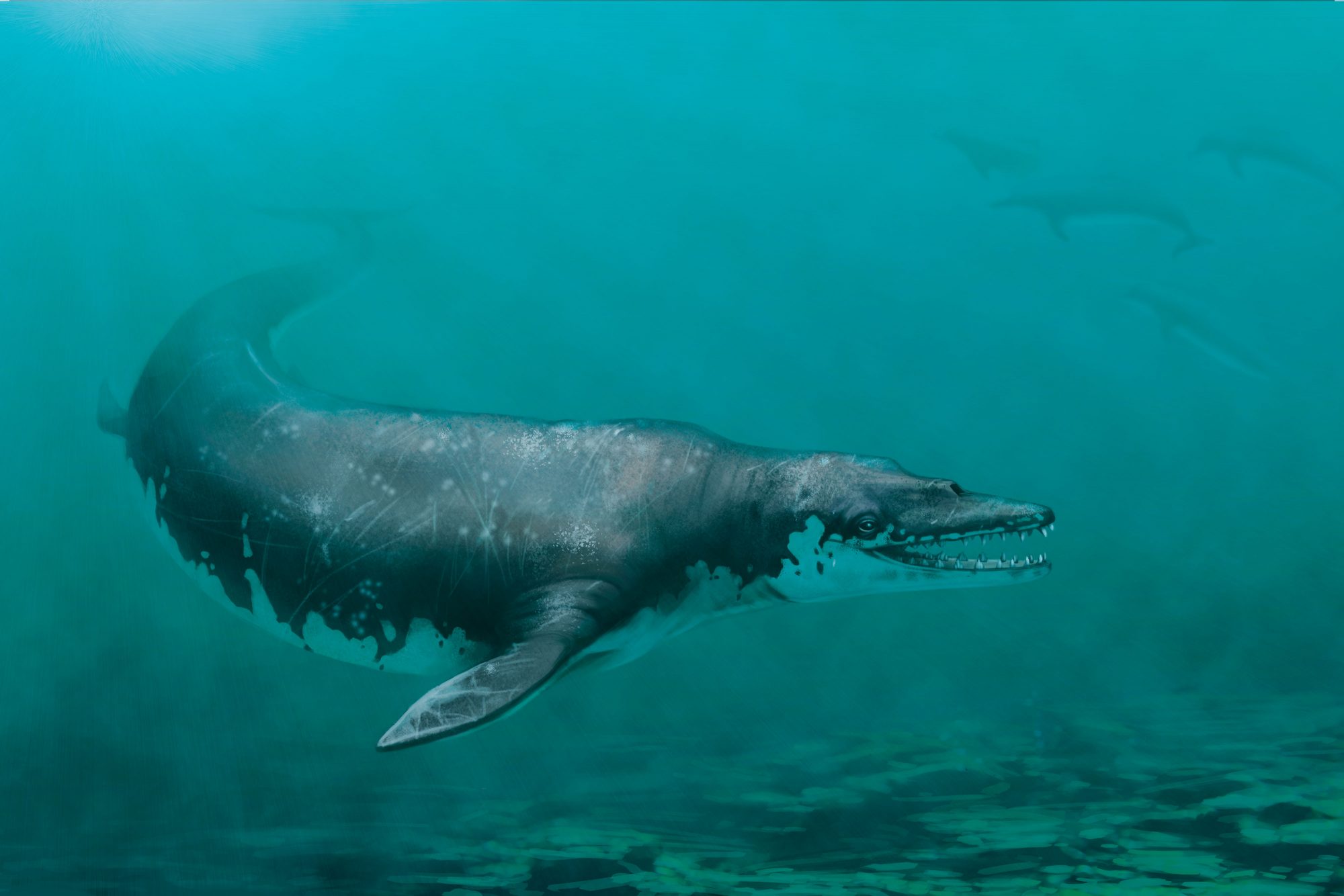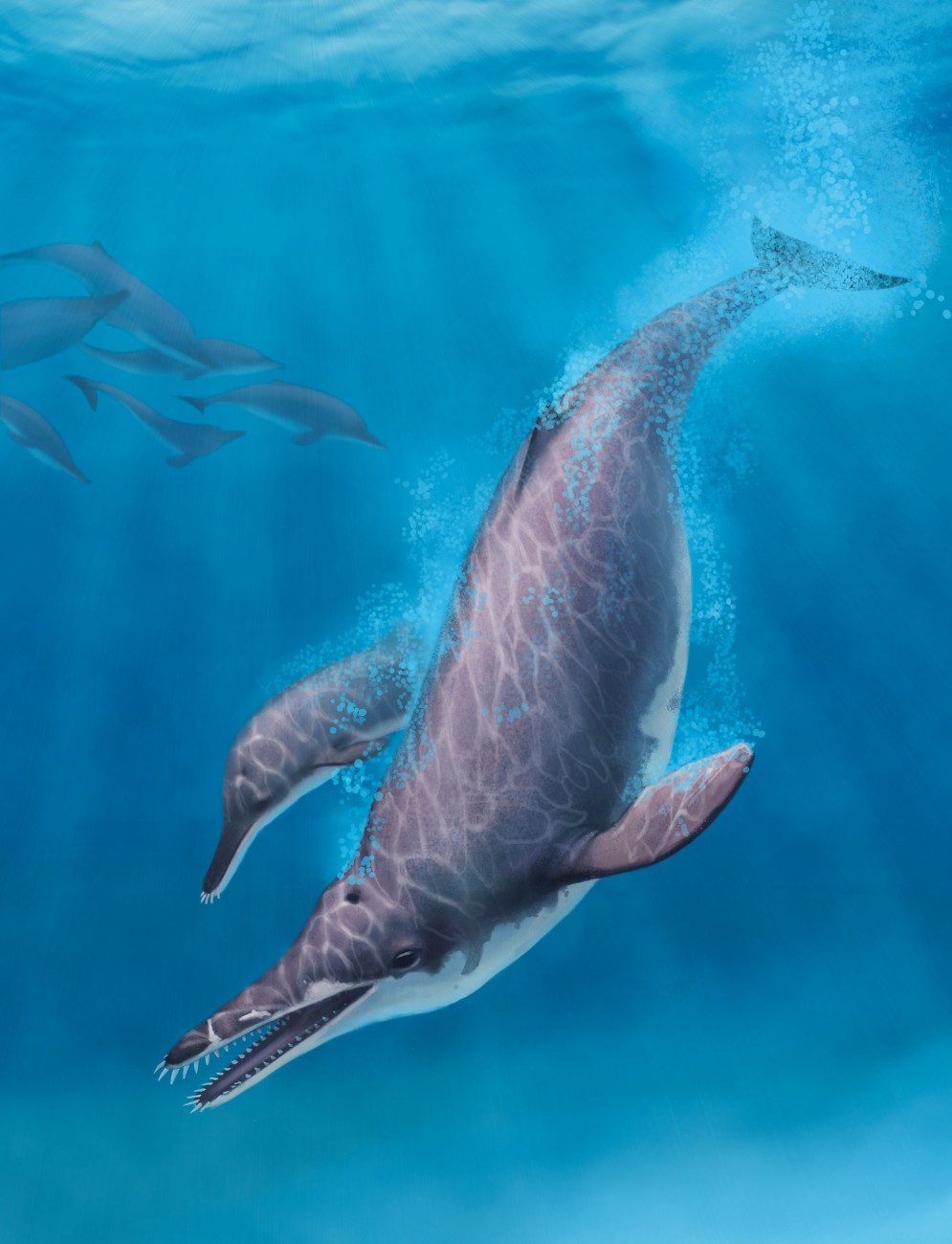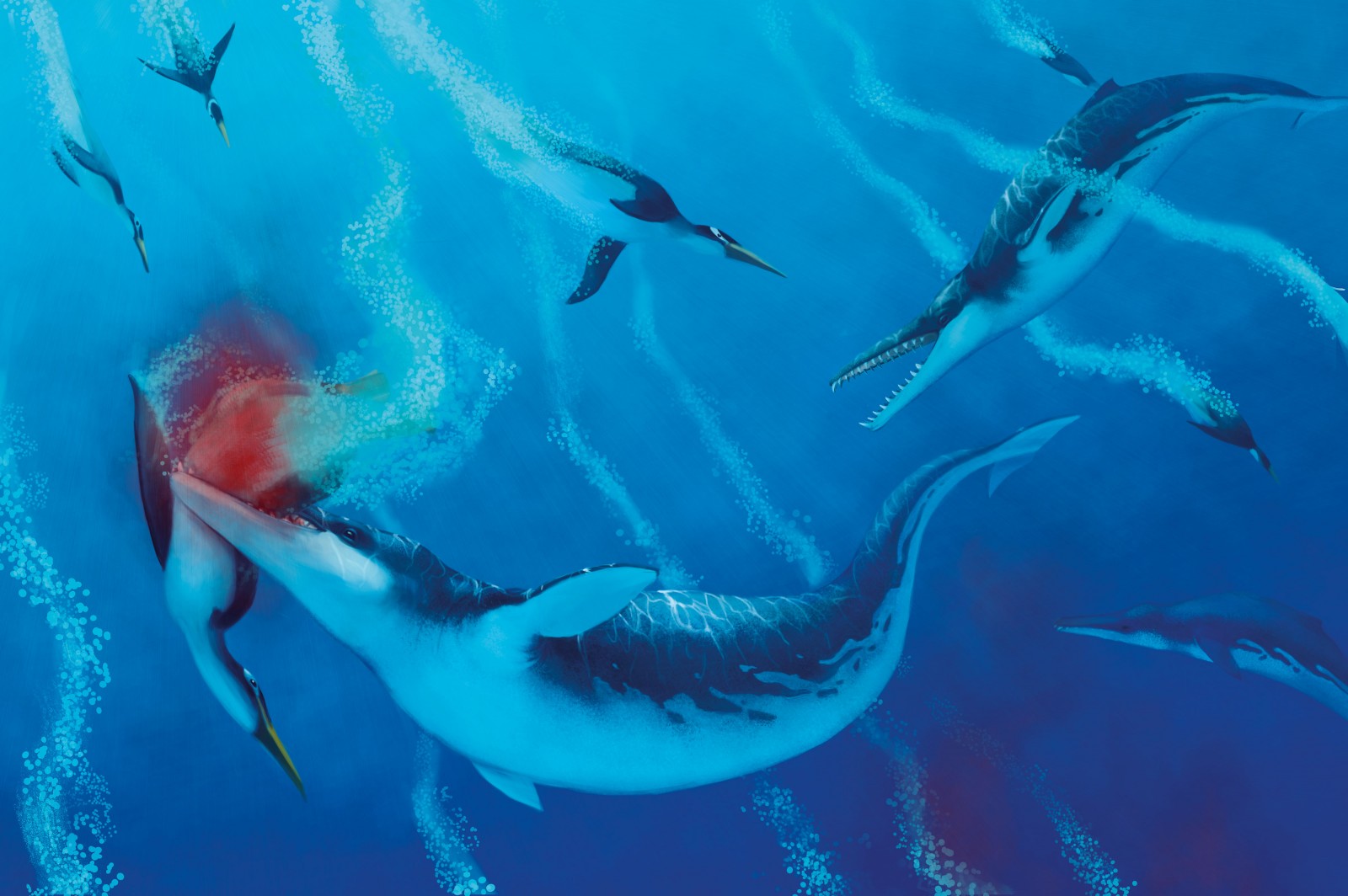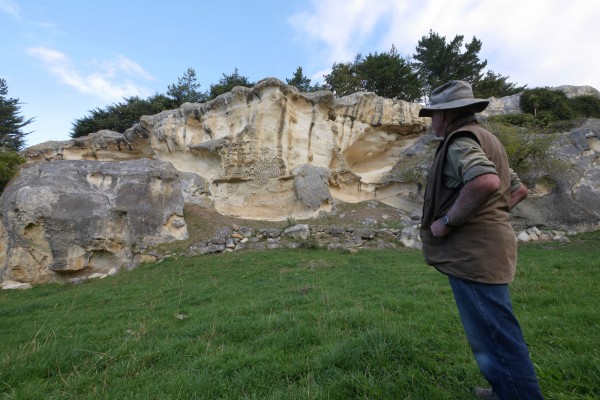
Valley of the whales
The North Otago limestone country holds one of the world’s most important fossil cetacean records, a coherent story of how whales and dolphins evolved in the Southern Ocean. It’s a story that one small rural community has embraced as its own.

Burns Pollock and I stand in the Valley of the Whales, a deep gulch cut by the Awamoko Stream through the North Otago limestone. Formed on the floor of an ancient sea, this terrain is now far from the ocean, its thin skin of agriculture desiccated by drought.
I’ve often been fascinated by the dramatic contours when travelling through this valley. But it also holds narratives, bound into the cliffs and sculpted recesses—Waitaha rock art hundreds of years old, and the story of evolution embodied in the stone itself. I’ve brought Pollock here because I want to see the place through the eyes of someone who knows it as well as he does. He grew up in this district and has farmed here all his life. He is also a noted artist and his work—sere vistas cradling broken fragments of human endeavour—is unmistakably rooted in this landscape.
“It’s in my bloodstream,” he tells me. “The more I see of it and the deeper I look into it, the more subtle and completely intangible facets I’m able to bring out. When people see it through your eyes for long enough, you lead them into a whole world of appreciation that’s incredibly satisfying.”
The foothills around Ngapara and Duntroon are overlain with thousands of hectares of limestone—the sedimentary signature of the warm ocean that covered Zealandia more than 23 million years ago, when the continent of which New Zealand is a part was almost completely submerged. It protrudes above irrigated farmland in great horizontal slabs, and crumbles off as boulders that lie around the place like the toys of giants.
This rock is important to science. It contains the richest known marine fossil record from the Oligocene epoch, a pivotal time in cetacean evolution when many of today’s great whales were radiating into their current forms.
The Valley of the Whales was given its mysterious title by a farmer whose property it divided. He was just one of a group of locals, including Pollock, who came together in 2002 to create the Vanished World Trail, a driving route that guides visitors through the paleontological and geological wonders of the region. It’s a unique project that has emerged from a rural community’s desire to share their love of the area, and from the remarkable work of one scientist who has dedicated his life to unlocking the secrets of this landscape.
[chapter-break]
Professor Ewan Fordyce is New Zealand’s only cetacean palaeobiologist and one of the world’s foremost authorities on the evolution of whales and dolphins. Based at the University of Otago, he has been venturing into the Waitaki region to retrieve fossils for more than three decades.
He invites me along on one of his regular trips to a quarry near Tokarahi to see if excavations there have exposed any fresh bone. As we walk around the bright, broken rock, he points out layers crammed with scallops and other shells, representing periods of time during which there was a hiatus in sedimentation that allowed these colonies to establish themselves. These ‘horizons’ are also the most likely places to find vertebrate remains—a perfectly preserved shark’s tooth, the wing bone of a giant penguin or the bones and teeth of a long-vanished species of whales or dolphins.
In the hour we spend exploring the quarry, Fordyce shows me at least three places where whale bones protrude from the chalky stone, an illustration of just how rich in fossils this landscape is.
Limestone is used as a soil additive and is also the region’s signature building material—everything from the Duntroon church to the pub in Kurow is made from it. Diggers and bulldozers regularly grind fossils to dust, unless Fordyce and his team of students are able to intervene in time.

Intervention means dragging heavy rock saws and pneumatic drills into quarries like this, excavating large blocks of fossil-bearing limestone, casing them in plaster for protection and carefully transporting them back to Dunedin—laborious work often conducted under time pressure.
“Sometimes we find a specimen late in the day, so we’ll just get what we can. It’s going to be ripped apart if we leave it,” says Fordyce. “I’ve got specimens that have got big saw cuts through them; I didn’t know where the bone was, I just had to cut somewhere.”
The heartbreak of losing fossils to the bulldozers is tempered by the fact that without quarry excavations, specimens would probably never see the light of day.
“Ideally I’d buy myself a shipping container to keep at a quarry and have a tiny grader. Every time they ripped there, I’d take my grader out and have a look at the rocks,” says Fordyce. “That would suit me just fine.”
Once the samples are safely returned to Dunedin, the limestone is cleaned away and the fossils examined for clues to their identity—anything from tiny protrusions on the ear bone to the shape of the skull can help determine the species, if it has ever been scientifically described. It can take months to completely extract a fossil from the stone, and years to reconstruct and formally name it.
“The key to understanding is to know the relationships between the species,” Fordyce explains. “Once you know the relationships, you can explain the history.
“It’s like dealing with a murder scene, but a murder scene from long ago where all the parts have been squeezed and distorted or partly dissolved.”
His laboratory at the end of the University of Otago’s geology building is crammed with the wreckage of extinction—vertebrae, jawbones and teeth. In the corner of his office, a 25-million-year-old dolphin skull sits delicately on a stand, its long jaw terminating in two bizarre tusks. What purpose this dentition fulfilled can only be guessed at.
There are even more fossils in the basement—far more than the small group of palaeontologists can hope to deal with. What drives Fordyce to keep collecting, and the reason there’s little room to move here for chunks of limestone, is the knowledge that science has barely tested these petrified waters.
The sheer wealth of the North Otago fossil record and Fordyce’s decades of work here have made this quiet corner of New Zealand a key location for this specialised science—postgraduate students now travel from around the world to work under his tutelage. They are evolutionary storytellers of a sort, working with the scattered words of a long-lost book to reveal the story of whale and dolphin evolution.
[chapter-break]
Around 50 million years ago, in the region of modern-day Pakistan, a group of hoofed carnivores took to the water, gradually abandoning the ability to walk on land and adapting to an aquatic existence. Over hundreds of generations, their front legs morphed into flippers and their tails into flukes, while their nostrils gradually shifted backwards towards the tops of their skulls. Their hind legs withered to stumps, finally disappearing altogether.
Freed from the constraints of terrestrial life, these proto-whales, archaeocetes such as Basilosaurus and Dorudon, soon colonised all the world’s oceans, and by the late Eocene—around 39 million years ago—were living and breeding in New Zealand waters.
Around the end of the Eocene epoch, 34–35 million years ago, a rift formed between Australia and Antarctica that allowed a cold current to circulate around the southernmost continent for the first time. This turned down the climate dial, allowing the polar ice cap to form and fuelling an explosion of microscopic algae called diatoms. This in turn triggered a huge increase in numbers of krill, which graze on these tiny oceanic plants.
According to Fordyce’s research, a group of whales in the Southern Ocean during the Oligocene evolved the ability to filter-feed as a means of catching the vast clouds of krill that then filled Antarctic seas. These were the ancestors of modern baleen whales, and they trapped krill by straining water through palm-shaped teeth and baleen, a fine mesh of fibre-fringed keratin plates hanging from the upper jaw. The adaptations meant they no longer had to be agile enough to chase down fast-moving prey—they could afford to grow big, which also afforded protection against predators. The whales quickly radiated into many forms, with early species possibly possessing both teeth and baleen.


The warm, shallow waters surrounding New Zealand at that time would have presented an attractive breeding and foraging environment for ancient cetaceans. Consequently, huge numbers of whale and dolphin bones came to rest on the seafloor here, among them Eomysticetes (very early baleen whales) and the extinct squalodontids, or shark-toothed dolphins.
These seas were also rich in sharks and other large fish, as well as penguins and other animals, which also fossilised under the right conditions. For millions of years, their remains were buried by the calcareous exoskeletons of tiny planktonic creatures—a steady rain of death and decay—until finally these piled-up sea-floors were lithified by time and pressure into limestone.
As the Oligocene drew to a close, changing land and sea levels raised the limestone into the open air. The Southern Alps were thrust up and resultant erosion scoured most of the soft rock away so that only outcrops of ancient seabed remain, such as those in North Otago.
Despite the geological upheavals of the past 20 million years, the Waitaki limestone units remain spectacularly undistorted. They resemble pancakes, each horizontal layer holding the story of an ocean different from the one before (below) and after (above). They provide a detailed snapshot of a period in history when cetaceans were in the midst of the evolutionary radiation that would ultimately lead to the great baleen whales of our time, including the humpback, blue and right whales with which we are so familiar.
[chapter-break]
The remarkable fossil record of the Waitaki region has intrigued scientists for more than a century and a half. Naturalist Walter Mantell dug New Zealand’s first recorded cetacean fossil from a creek bed near Oamaru in 1848. Three decades later, geologist and explorer Alexander McKay recovered a new Basilosaurus-like fossil from a tributary of the Waitaki River near Kurow. Basilosaurids were already well known from elsewhere in the world, but McKay’s fossils revealed for the first time the global range of these large-toothed predators.
McKay returned to the same spot to excavate the bones of up to five other ancient whales, one of them an almost complete seven-metre-long skeleton, perhaps the most spectacular cetacean fossil ever recovered in New Zealand. Tragically, it was damaged beyond repair on its way to Wellington.

For most of the 20th century, cetacean fossil research proceeded sporadically and often as a by-product of other studies. University of Otago professors William Benham and later Brian Marples collected and named several important species from the North Otago region, but it wasn’t until Ewan Fordyce began conducting systematic research in the late 1970s that studies began progressing with any real momentum.
Alongside his many whale and dolphin discoveries, Fordyce has also unearthed extinct giant penguins and a Cretaceous sea monster called a plesiosaur, an almost complete specimen recovered after months of painstaking work from the coastal village of Shag Point. Today, the plesiosaur, officially named Kaiwhekea katiki but fondly referred to as ‘Shagosaurus’, is on loan to the Otago Museum, where it takes pride of place in the main gallery.
[chapter-break]
Enticing travellers to stop and spend money in Duntroon has always been a challenge. The tiny village lies stranded between the coastal city of Oamaru and the inland lakes and mountains. Most travellers barrel through with little regard for the town’s rich history and numerous attractions—even the recently developed Alps to Ocean Cycle Trail passes the township by, hugging the Waitaki River instead.
In the early 2000s, a Waitaki district councillor and retired academic, Helen Brooks, was looking for ways to revive the flagging economy of the area. Seeing the tourism potential of the region’s pre-history, she got in touch with Ewan Fordyce, and the Vanished World Trail concept was born.
“The view that Ewan and I had was a drawcard for this district that was strongly scientifically based, so international scientists could come and read material which was accurate according to the science of the day,” she explains.
Fordyce’s years of exploring farms in the area had given him a strong affinity with the rural community.
Many of the farmers whose land he regularly accessed had become personal friends and were fascinated by the stories Fordyce could tell them about the rock that underlay their properties.
Brooks and Fordyce pulled together a dedicated group of farmers and others whose passion for the area and status in the community gave the project impetus, and who allowed public access to their properties.
One of the first to be contacted was John Hore, who for most of his life has farmed a rolling block of limestone country named Anatini, meaning ‘many caves’. Hore’s property is bisected by a deep gully in which the producers of the first Chronicles of Narnia movie found a suitable setting for their otherworldly tale in 2004. (“There were 600 people working on the farm,” he tells me. “It took a bit of adjustment.”)
In 2003, Hore and the rest of the Vanished World group worked tirelessly to put the trail together, spending thousands of hours building tracks, fences and stiles, and converting a disused store in Duntroon into a visitors’ centre. The University of Otago also threw its weight behind the project, and Fordyce spent weeks preparing signage and information panels.

Today, the Vanished World Trail stretches across North Otago, leading visitors from the Moeraki Boulders on the coast, inland to limestone outcrops with evocative names such as Earthquakes and Elephant Rocks. There are at least two places where visitors can see whale fossils in situ, their jumbled symmetry emerging from the creamy-white rock like chaotic Greek friezes. One of these, a pile of vertebrae and jawbones from an early baleen whale, is found in the same gully in which the Narnia film was shot.
At Earthquakes, the land has fractured and slumped, creating a secluded gully overhung by towering limestone bluffs from which great boulders have broken off and lie marooned on the ground below. “It’s like a glacier,” says Hore. I can immediately see the similarity—the huge shards of stone calving off the face of a wall of rock as if it were made of ice, a glacier in deep time. One day, these mighty precipices and the fossils they hold will be ground away by wind and rain and washed to the ocean, where the minerals bound up in the rock will once again re-enter the cycle of life, death and lithification. But here and now, this valley is a time capsule, filled with the memories of creatures from another era, ghosts of time that turn up in the most unexpected places.
John Hore’s farmhouse was built a century ago out of limestone blocks carved from a nearby cliff. A shed was later built in the cavity left by the quarrying. A few years ago, Hore was rummaging around in the back of the shed and, behind a stack of hay bales, discovered a dolphin skeleton embedded in the wall. It was 25 million years old.

















